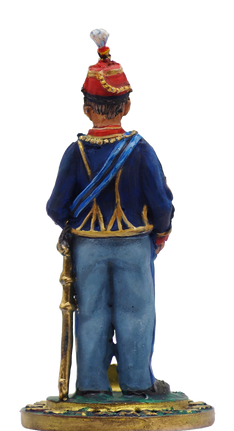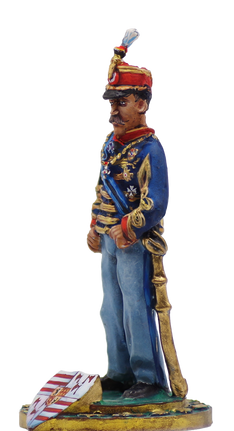
Auguste-Étienne de Croÿ
Prince of Croÿ and Solre
Auguste-Étienne de Croÿ, Prince de Croÿ et de Solre, born in Le Rœulx on 18 October 1872 and died in Paris on 4 June 1932, was a Belgian aristocrat and diplomat. He was appointed Grand Bailiff of the Sovereign Order of Malta and made a Knight of the Order of the Golden Fleece. He pursued a career in diplomacy and was appointed Belgian ambassador to Austria. He was admitted to the nobility of the Kingdom of Belgium with the title of Prince and the predicate of Serene Highness. He died in Paris on 4 June 1932. He married in Heverlee on 2 December 1896, H.S.H. Marie-Salvatrix, Princess and Duchess of Arenberg (born in Heverlé on 26 April 1874), daughter of H.S.H. Engelbert-Auguste, Duke of Arenberg, and H.S.H. Eleonore, Princess and Duchess of Arenberg. She died at Le Reulx on 9 May 1956.


The 2th Chasseurs à Cheval Regiment (Dutch: 2 Regiment Jagers te Paard, French: 2 Régiment de Chasseurs à Cheval) was a cavalry regiment of the Belgian Armed Forces. In March 1814, Prince Ferdinand de Croÿ received permission to create a regiment of Hussars. It was part of Légion Belge until 1 September 1814, when it was integrated in the army of the United Kingdom of the Netherlands. When William I became King of the Netherlands, the Belgian Regiment of Hussars of Croÿ becomes the 8th Regiment of Hussars. The regiment kept its original uniform until after the Battle of Waterloo, where it was part of the Dutch-Belgian cavalry. After the Belgian Revolution, the 8th Hussar Regiment become the 2nd Regiment of Chasseurs à Cheval (ChCh), by decree of the Provisional Government of Belgium in October 1830. Its first commander was Colonel d'Hanne de Steenhuyse in Ghent.

The House of Croÿ is an old European noble family of princely and historically sovereign rank, which held a seat in the Imperial Diet from 1486, and was elevated to the rank of Princes of the Holy Roman Empire in 1594. In 1533 they became Dukes of Arschot (in Belgium) and in 1598 Dukes of Croy in France. As a former ruling and mediatized family, it belongs to the Hochadel (high nobility). In 1904, the family had branches in Belgium, France, Austria and Prussia. This dynastic house, which originally adopted its name from the Château de Crouy-Saint-Pierre in French Picardy, claimed descent from the Hungarian Prince Marc, (if true, he was likely a grandson of Prince Géza) who allegedly settled in France in 1147, where he married an heiress to the barony of Croÿ. The Croÿ family rose to prominence under the Dukes of Burgundy. Later, they became actively involved in the complex politics of France, Spain, Austria, and the Low Countries. Among the more illustrious members of the House of Croÿ were two bishop-dukes of Cambrai, two
cardinals (one being also the Archbishop of Toledo and another being the Archbishop of Rouen), five bishops (those of Thérouanne, Tournai, Cammin, Arras, and Ypres), one prime minister of Philip the Good, one finance minister, archchancellor, chief admiral, godfather and tutor of Holy Roman Emperor Charles V (himself godfather to another Croÿ), one Grand-Bouteiller, one Grand-Maitre and one Marshal of France; one Grand Equerry of the King of Spain, several imperial field marshals and twenty generals, four finance ministers of the Netherlands, two governors of the Netherlands and Belgium, one Russian field marshal; numerous ministers, ambassadors and senators in France, Austria, Belgium, and a record of thirty-two knights of the Order of the Golden Fleece. The head of the house bears the title of duke, with all the other members titled as princes or princesses. All of them bear the predicate of Serene Highness. The only line of the House of Croÿ existing today, that of Croÿ-Solre, descends from Antoine le Grand's younger brother, Jean II de Croÿ (1395–1473), who governed Hainaut and Namur in the name of the Dukes of Burgundy. His dominions were centred on the town of Chimay, of which he became the first count. In 1430, he was made one of the first Knights of the Order of the Golden Fleece. Jean II's grandson, Count Charles de Croÿ-Chimay (1455–1527), made a name for himself in the Battle of Guinegate in 1479. He succeeded to the county of Chimay in 1482 and to the possessions of his mother, a countess of Mors-Saarwerden, several years later. In 1500, Charles was summoned to take part in the baptism of the future emperor Charles V, during whose minority he served as one of the governors. The Prince of Chimay had many children by his wife, Louise d'Albret, sister of Jean d'Albret, King of Navarre. Only two daughters reached the age of majority, Anne inheriting Chimay while Marguerite obtained Wavrin. The former married a cousin, Philippe II de Croÿ, Duke of Arschot (see above), and their children succeeded to the principality of Chimay. Jacques III de Croÿ-Sempy (1508–1587) was Jean II's great-grandson and Charles de Chimay's nephew. It was through his mother, Louise of Luxembourg, that he succeeded to the Château of Fontaine-l'Évêque in 1529, later obtaining more lands as a dowry for his three marriages. His last wife, Yolande de Lannoy, brought the manors of Molembais, Solre, and Tourcoing to the House of Croÿ. Their son Philippe was the first to style himself Count of Solre. He died in Bohemia in 1612, leaving two daughters and four sons, of whom the eldest succeeded as the 2nd Count of Solre. A younger son married the 1st Duchess of Havré, giving birth to the second line of Croÿ-Havré, which expired in 1839. Towards the end of the 18th century, as other branches of the family were coming to an end, the line of Croÿ-Solre accumulated a number of their titles and possessions. During the French Revolution, Anne Emmanuel de Croÿ, 8th Duke of Croÿ (1743–1803), moved his seat from Le Rœulx to the Westphalian town of Dülmen, formerly a possession of his wife, a princess of Salm-Kyrburg. Among his sons, Prince Gustave of Croÿ (1773–1844) rose to become a cardinal and archbishop of Rouen. Another son, Auguste de Croÿ, 9th Duke of Croÿ, better known as Le Bel Auguste (1765–1822), was mediatized upon the demise of the Holy Roman Empire in his capacity as sovereign prince of Dülmen. When the Bourbons were restored to the throne of France, Auguste was made a peer of France. From three of Auguste's sons – Alfred, Ferdinand and Philipp Franz – descend the three extant branches of the House of Croÿ, residing in Germany and France.
Awards: Collar and star of the Sovereign Military Hospitaller Order of Saint John of Jerusalem, of Rhodes and of Malta, insignia of the Distinguished Order of the Golden Fleece, sash and star of the Order of Leopold II.






